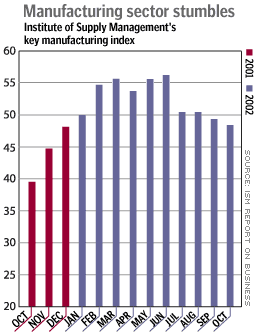NEW YORK (CNN/Money) - Manufacturing activity in the United States shrank for a second straight month in October, the nation's purchasing managers said Friday.
The Institute for Supply Management (ISM) said its key gauge of manufacturing activity came in at 48.5 percent in October, compared with 49.5 percent in September. Any reading under 50 percent indicates contraction in the sector. Economists had expected a reading of 48.9 percent, according to Briefing.com.
"The sector lacks drivers at this point," said Norbert Ore, chairman of the ISM's survey committee. "While new orders are relatively unchanged, the uncertainty with regard to terrorism and potential military action continue to add to the stagnation. Capital spending for additional capacity and IT [information technology] is very soft."

Though worse than consensus expectations, the report briefly helped U.S. stock prices erase some of their earlier losses, as some traders had expected the report to be far worse. Treasury bond prices fell.
Wall Street had several other reports to sort out as well, as the Labor Department said unemployment crept up in October, the Commerce Department said personal income rose and personal spending fell in September, while in a separate report it said construction spending rose 0.6 percent in September.
Friday's manufacturing report followed one Thursday from the National Association of Purchasing Management-Chicago that said factory output in the Midwest contracted for the second straight month. That report was so bad, in fact, that many economists worried Friday's ISM report would be much worse than consensus expectations.
"Yes, the published consensus estimate was higher, but that survey was compiled before the Chicago PM was released," said Anthony Chan, chief economist at Banc One Investment Advisors. "After that number was released, many Wall Street investors feared that we could see a 47 or 48 reading [for ISM]."
In its report, the ISM said its employment index rose slightly to 45 from 44.9 percent in September, still an indication that businesses were cutting jobs.
Proof of that trend was found in Friday's report from the Labor Department on October unemployment, which said goods-producing businesses slashed 75,000 jobs from their payrolls last month, while service-producing businesses added 70,000.
"It appears that manufacturing employment is significantly lagging other recoveries," Ore said.
The ISM's new orders index rose to 50.9 from 50.2 in September, the second straight month above 50, indicating manufacturing activity could pick up again in the future.
Manufacturing has been struggling since late 2000, when businesses abruptly stopped spending on factory improvements and new technology. The industry fell into an 18-month-long recession, the precursor to a broader U.S. recession that began in March 2001.
Manufacturing bounced back earlier this year, growing for seven straight months, but fell back into contraction in September as businesses curtailed spending again after a brutal stock sell-off.
Economists expect the overall economy to be weaker in the fourth quarter, which could spur the Federal Reserve to cut its target for short-term interest rates next Wednesday. The Fed cut rates 11 times in 2001 and has left rates alone all year. Most economists expect a Fed cut next week, and Friday's glut of reports did little to change that view.

|

